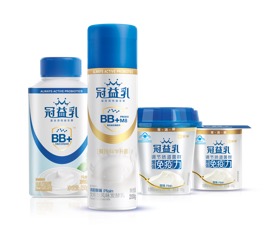合理膳食、科学营养是提高全民健康的重要环节。中国营养学会近日发布了营养膳食指导,针对新型冠状病毒感染的肺炎防控和救治特点提出“酸奶,能够提供肠道益生菌,适合不同类型消费者日常补充”。

除了中国,很多国家的官方指南也把酸奶做为合理膳食的重要组成部分。

中国:奶类及奶制品300g/天

法国:建议饮奶每天3次,儿童和青少年可以每天4次。比如每次一杯125g酸奶、一个100g夸克、干酪60g、奶酪30g或一杯牛奶

美国:乳制品(包括酸奶)708mL/天

日本:奶类及奶制品200mL/天

澳大利亚:奶类及奶制品200mL/天
那么,活菌酸奶有哪些好处呢?
一 优质蛋白质
酸奶中的蛋白含有人体所需的所有必需氨基酸,是优质蛋白质的良好来源。在发酵中,部分乳蛋白被分解成小分子肽和氨基酸,更容易被消化吸收。酸奶蛋白消化率可达97%以上。

二、 活菌
酸奶中含有丰富的乳酸菌,长期食用可以有效改善肠道健康状况。益生菌酸奶,更是含有数以亿计的益生菌,能够经受住胃酸和胆盐的考验,到达肠道,产生有益代谢产物,促进有益菌生长,抑制有害菌繁殖,起到调节肠道微生态的作用。

三 原生乳钙
酸奶是日常膳食中钙的良好来源。酸奶保留了生牛乳中丰富的钙含量,而且在发酵的过程中还会产生促进钙等矿物质吸收的乳酸。因此,酸奶中的乳钙更加容易被人体吸收。
四 维生素及多种微量元素
除了钙,酸奶在发酵过程中还可以产生人体所必需的多种维生素。美国营养与健康调查数据(NHANES)表明,增加乳制品的消费量,可以帮助弥补维生素和微量元素的不足。
五 乳糖不耐者首选
酸奶中的乳酸菌会分解酸奶中的乳糖,使乳糖含量降低。因此,对于乳糖不耐的人,可首选酸奶做为乳制品来源。
六 能量密度低,可以作为健康零食替代
酸奶的能量密度低,作为零食或饮食的一部分来食用,有助于控制饥饿感,减少能量摄入。
因此,长期坚持食用低温活菌酸奶是健康饮食和生活方式的标志。

参考文献
1.What is Yogurt? Process, history and frequently asked questions, YINI(YOGURT IN NUTRITION INITIATIVE FOR A BALANCE DIET)
2. 董开发, 徐明生. 酸奶的营养保健作用[J]. 中国食物与营养, 2000(2).
3. 《中国居民膳食指南》2016版
4. 刘国信. 酸奶:如何饮用更有益健康[J]. 心血管病防治知识,2011(5):64-65.
5.许宝雁. 酸奶的制作及拓展探究实验[J]. 中学生物学, 2013,29(9):46-47.
6. YINI Digest, 2014. What added value does yogurtbring to dairy protein?
http://www.yogurtinnutrition.com/wpcontent/uploads/2015/03/digest_issue-01.pdf.Last accessed 15 May 2018.
7. Adolfsson O, Meydani SN, Russell RM. Yogurt andgut function. Am J Clin Nutr 2004;80(2):245-56.
8.Demmer E, Cifelli CJ, Houchins JA, et al. Theimpact of doubling dairy or plant-based foods>9.Table Ciqual des aliments 2008, ANSES ;Directive européenne (90/496/CEE).
10.Martin A et al. Apports nutritionnels conseilléspour la population française, 3rd edition, Ed TEC&DOC 2007 pp 605.
11.Mozaffarian D, Hao T,Rimm EB, et al. Changes in diet and lifestyle and long-term weight gain inwomen and men. N Engl J Med 2011;364:2392–404.
12.Cormier H, Thifault É,Garneau V, et al. Association between yogurt consumption, dietary patterns, andcardio-metabolic risk factors. Eur J Nutr 2016;55:577–87.
13.Aune D, Norat T,Romundstad P, et al. Dairy products and the risk of type 2 diabetes: asystematic review and doseresponse meta-analysis of cohort studies. Am J ClinNutr 2013;98:1066–83.
14.Chen M, Sun Q,Giovannucci E, et al. Dairy consumption and risk of type 2 diabetes: 3 cohortsof US adults and an updated meta-analysis. BMC Med 2014;12:215.
15.Gijsbers L, Ding EL,Malik VS, et al. Consumption of dairy foods and diabetes incidence: adose-response metaanalysis of observational studies. Am J Clin Nutr 2016;103:1111–24.
16.O’Connor LM, Lentjes MA,Luben RN, et al. Dietary dairy product intake and incident type 2 diabetes: aprospective study using dietary data from a 7-day food diary. Diabetologia2014;57:909–17.
17.Drouin-Chartier JP,Brassard D, Tessier-Grenier M, et al. Systematic review of the associationbetween dairy product consumption and risk of cardiovascular-related clinicaloutcomes. Adv Nutr 2016;7:1026–40.18.Givens DI. Saturatedfats, dairy foods and health: a curious paradox? NutritionBulletin2017;42:274–82. https://onlinelibrary.wiley.com/doi/full/10.1111/nbu.12283.Last accessed 15 May 2018.
作者:蒙牛营养研究院 孙健博士
本文原载自《中国乳业》杂志 乳业资讯网